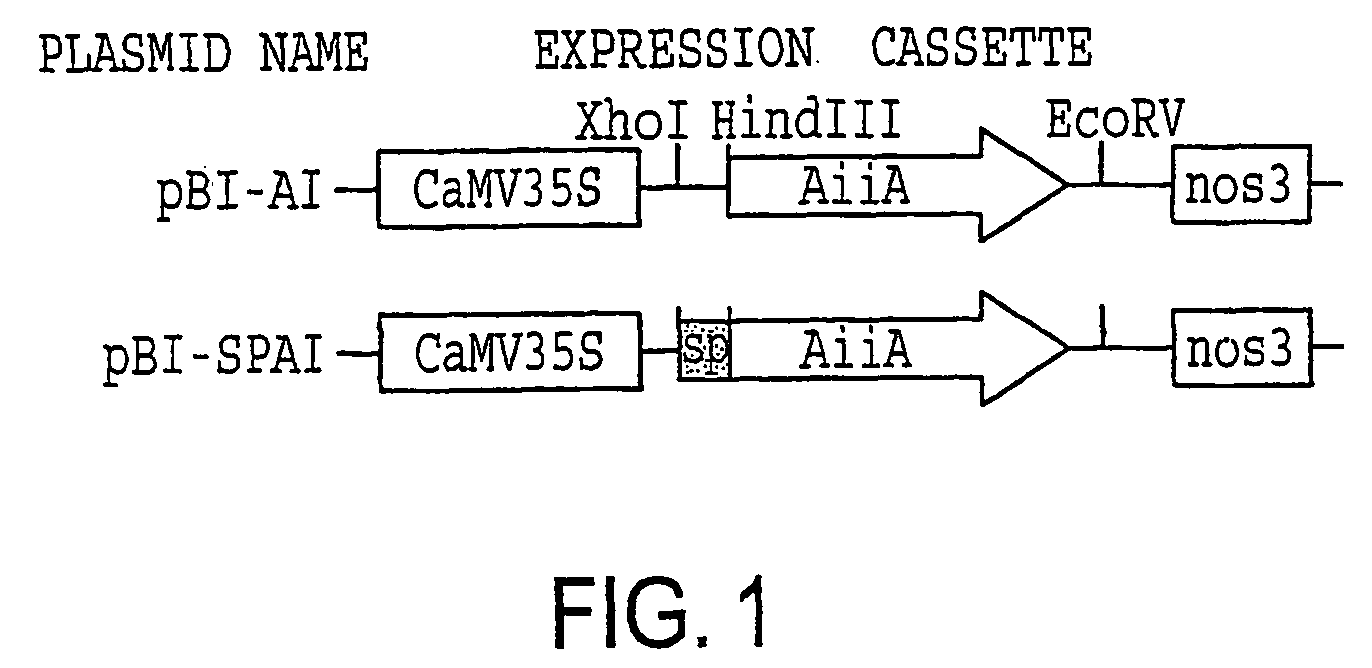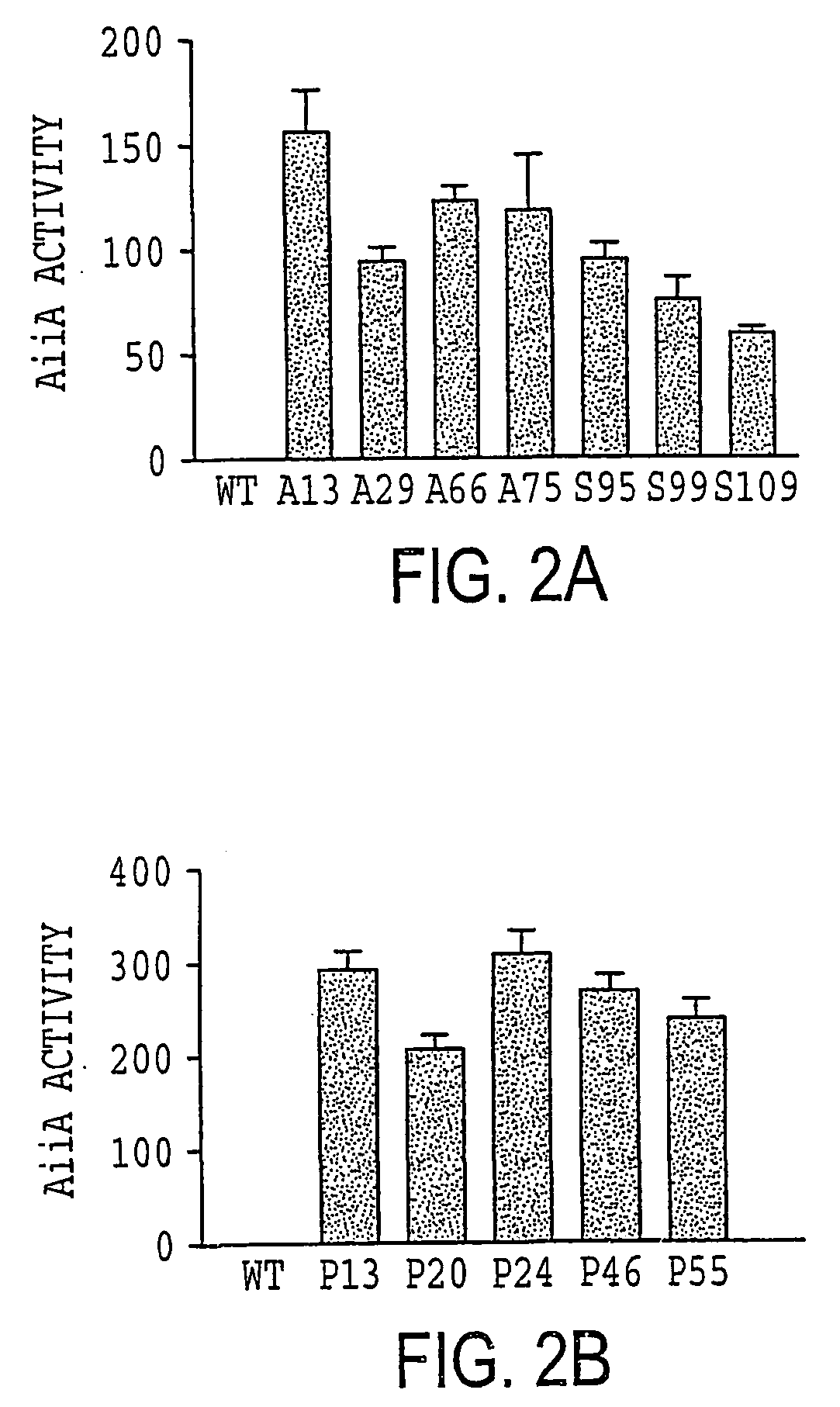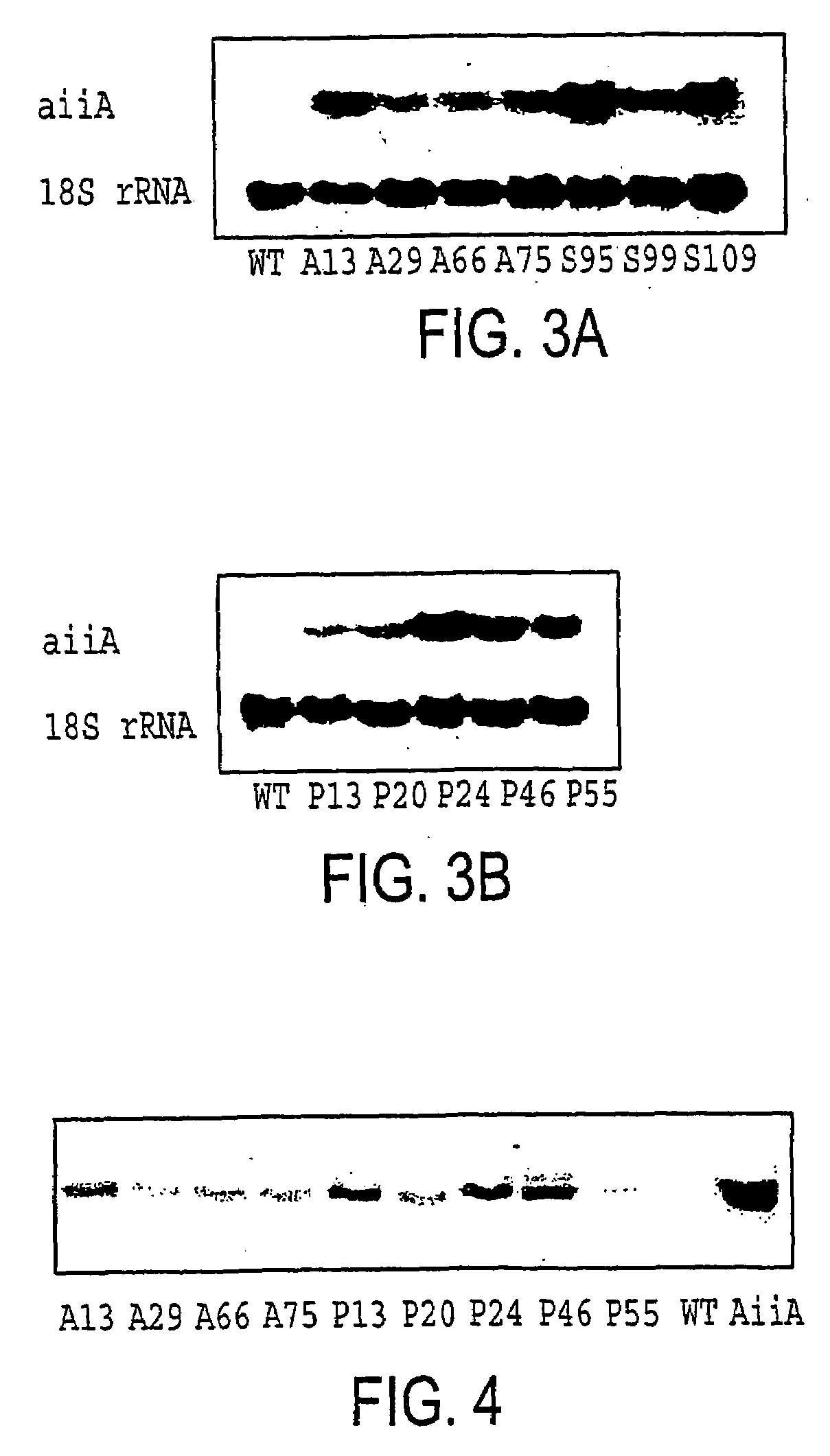Control of bacterial infection by quenching quorum-sensing of plant pathogenic bacteria
a technology of bacterial infection and quorum sensing, which is applied in the field of genetic manipulation of plants, can solve problems such as soft rot and bacterial microbial symptoms in plants
- Summary
- Abstract
- Description
- Claims
- Application Information
AI Technical Summary
Problems solved by technology
Method used
Image
Examples
example 1
Transformation of Plants with the aiiA Gene
[0034]Two aiiA gene constructs were generated for transformation of tobacco and potato. The DNA fragment containing the aiiA coding region was produced by digestion of pGEM7-aiiA (Dong et al., 2000; accession number AF196486) with KpnI and EcoRV. The fragment was ligated into the cloning vector pBluescript SK to produce pBS-aiiA. A XhoI-SacI fragment containing the aiiA from pBS-aiiA was ligated into the plant transformation vector pBI121 between the CaMV 35S promoter and the Agrobacterium nos terminator to generate the construct pBI-AI which contains a kanamycin resistance gene as the selection marker. See FIG. 1.
[0035]For generation of a fusion gene encoding for a signal peptide-AiiA fusion protein which could be targeted into plant intercellular spaces, the signal peptide (SP) coding region of Nicotiana plumbaginifolia calreticulin protein (Borisjuk et al., 1998; accession number Z71395) was generated by PCR amplification. The primers we...
example 2
Protein Extraction and Assay for AiiA Enzyme
[0039]To test for AiiA enzyme activity in the transgenic plants, total soluble protein was extracted from tobacco leaves and potato tubers by homogenizing 1 g fresh tobacco leaf tissue with 1.5 ml protein extraction buffer (100 mM Tris-HCl, pH 8.0; 10 mM MgCl2; 18% (w / v) sucrose; 40 mM 2-mercaptoethanol) or 1 g potato tuber tissue with 1.0 ml protein extraction buffer. The homogenates were sedimented at 10,000×g for 15 min at 4° C. to remove debris. The supernatant was then used for both protein and enzyme activity assay. Protein concentration was determined by the Bio-Rad™ protein assay method according to manufacturer's instructions, using bovine serum albumin as a standard.
[0040]AiiA enzyme activity was assayed by adding different amounts of the total protein extracts (5, 10 or 20 μl) to 10 μl of 40 μM OHHL in a total volume of 30 μl and incubating the mixture for 30 min at 28° C. The digested OHHL concentration was determined by plate ...
example 3
Expression Analysis of Transgenic Plants
[0042]Transcription expression of the aiiA gene in transgenic tobacco and potato was determined by RNA hybridization. Total RNA was extracted from tobacco and potato leaves by the TRIZOL method (Gibco-BRL). Total RNA (10 μg) was fractionated in 1.2% formaldehyde-agrose gels and transferred to Hybond —N+ (Amersham) nylon membranes. The aiiA coding region and the tobacco 18S rRNA fragment was radiolabelled with α-p32-dCTP using the random prime labeling system (Rediprime™ II, Amersham). The RNA samples were hybridized initially with the aiiA probe and then with the 18S rRNA probe to confirm equivalent RNA loading. After hybridization, the membranes were washed twice for 30 min in 2×SSC (17.53 g / L NaCl, 8.82 g / L sodium citrate, pH 7.0) containing 0.1% SDS at 65° C. and twice for 30 min in 0.2×SSC containing 0.1% SDS at 65° C. See FIG. 3, which provides the RNA gel blot data. All tested lines contained RNA transcripts, confirming transcription of ...
PUM
| Property | Measurement | Unit |
|---|---|---|
| volume | aaaaa | aaaaa |
| volume | aaaaa | aaaaa |
| volume | aaaaa | aaaaa |
Abstract
Description
Claims
Application Information
 Login to View More
Login to View More - R&D
- Intellectual Property
- Life Sciences
- Materials
- Tech Scout
- Unparalleled Data Quality
- Higher Quality Content
- 60% Fewer Hallucinations
Browse by: Latest US Patents, China's latest patents, Technical Efficacy Thesaurus, Application Domain, Technology Topic, Popular Technical Reports.
© 2025 PatSnap. All rights reserved.Legal|Privacy policy|Modern Slavery Act Transparency Statement|Sitemap|About US| Contact US: help@patsnap.com



